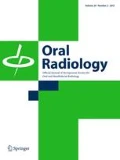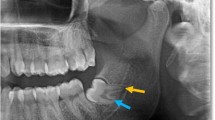Abstract
Paraesthesia of the lower lip during orthodontic treatment is rare. We present a case of unilateral temporary mental paraesthesia elicited by fixed orthodontic appliance therapy. The cause for the paraesthesia was thought to be close contact between the inferior dental nerve and the mandibular tooth roots. A cone beam computed tomography (CBCT) scan revealed intimate contact between the roots of the lower left second molar and the inferior alveolar canal. The use of imaging techniques to assess the relationship between the inferior dental nerve and tooth roots is discussed. Although anatomical relationships between nerves and tooth roots can be diagnosed using a variety of imaging techniques, CBCT is suggested as the imaging modality of choice as high-resolution images are produced at a relatively low dose to the patient.





Similar content being viewed by others
References
Colella G, Cannavale R, Vicidomini A, Lanza A. Neurosensory disturbance of the inferior alveolar nerve after bilateral sagittal split osteotomy: a systematic review. J Oral Maxillofac Surg. 2007;65:1707–15.
Jerjes W, Upile T, Shah P, Nhembe F, Gudka D, Kafas P, et al. Risk factors associated with injury to the inferior alveolar and lingual nerves following third molar surgery-revisited. Oral Surg Oral Med Oral Pathol Oral Radiol Endod. 2010;109:335–45.
Lopez-Lopez J, Estrugo-Devesa A, Jane-Salas E, Segura-Egea JJ. Inferior alveolar nerve injury resulting from overextension of an endodontic sealer: non-surgical management using the GABA analogue pregabalin. Int Endod J. 2012;45:98–104.
Wright EF. Persistent dysesthesia following dental implant placement: a treatment report of 2 cases. Implant Dent. 2011;20:20–6.
Zmener O. Mental nerve paresthesia associated with an adhesive resin restoration: a case report. J Endod. 2004;30:117–9.
Krogstad O, Omland G. Temporary paresthesia of the lower lip: a complication of orthodontic treatment. A case report. Br J Orthod. 1997;176:29–30.
Baxmann M. Mental paresthesia and orthodontic treatment. Angle Orthod. 2006;76:533.
Farronato G, Garagiola U, Farronato D, Bolzoni L, Parazzoli E. Temporary lip paresthesia during orthodontic molar distalization: report of a case. Am J Orthod Dentofacial Orthop. 2003;42:761–9.
Monini ADA, Martins RP, Martins IP, Martins LP. Paresthesia during orthodontic treatment: case report and review. Quintessence Int. 2011;42:761–9.
Noordhoek R, Strauss RA. Inferior alveolar nerve paresthesia secondary to orthodontic tooth movement: report of a case. J Oral Maxillofac Surg. 2010;68:1183–5.
Stirrups DR. Temporary mental paraesthesia: an unusual complication of orthodontic treatment. Br J Orthod. 1985;12:87–9.
Tang NC, Selwyn-Barnett BJ, Blight SJ. Lip paraesthesia associated with orthodontic treatment—a case report. Br Dent J. 1994;176:29–30.
Willy PJ, Brennan P, Moore J. Temporary mental nerve paraesthesia secondary to orthodontic treatment—a case report and review. Br Dent J. 2004;196:83–4.
Erickson M, Caruso JM, Leggitt L. Newtom QR-DVT 9000 imaging used to confirm a clinical diagnosis of iatrogenic mandibular nerve paresthesia. J Calif Dent Assoc. 2003;31:843–5.
Rood JP, Shehab BA. The radiological prediction of inferior alveolar nerve injury during third molar surgery. Br J Oral Maxillofac Surg. 1990;28:20–5.
Fox NA. The position of the inferior dental canal and its relation to the mandibular second molar. Br Dent J. 1989;167:19–21.
Kuzmanovic DV, Payne AG, Kieser JA, Dias GJ. Anterior loop of the mental nerve: a morphological and radiographic study. Clin Oral Implants Res. 2003;28:20–5.
Aryatawong S, Aryatawong K. Evaluation of the inferior alveolar canal by cross-sectional hypocycloidal tomography. Implant Dent. 2000;9:339–45.
Conflict of interest
Louisa Sham, Anant Bakshi, Hashmat Popat and Nicholas Drage declare that they have no conflict of interest.
Human rights statements and informed consent
All procedures followed were in accordance with the ethical standards of the responsible committee on human experimentation (institutional and national) and with the Helsinki Declaration of 1975, as revised in 2008. Informed consent was obtained from the patient to be included in this case report.
Author information
Authors and Affiliations
Corresponding author
Rights and permissions
About this article
Cite this article
Sham, L., Bakshi, A., Popat, H. et al. Orthodontic induced inferior alveolar nerve paraesthesia: diagnosis using cone beam computed tomography. Oral Radiol 30, 255–258 (2014). https://doi.org/10.1007/s11282-014-0174-4
Received:
Accepted:
Published:
Issue Date:
DOI: https://doi.org/10.1007/s11282-014-0174-4




